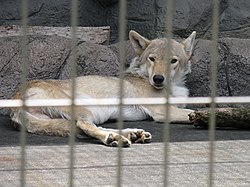Mongolian wolf
Canis chanco was the scientific name proposed by John Edward Gray in 1863 who described a skin of a wolf that was shot in Chinese Tartary.
[2] This specimen was classified as a wolf subspecies Canis lupus chanco by St. George Jackson Mivart in 1880.
[7] There are some researchers who still refer to Pocock's classification of the Tibetan wolf as C. l. chanco, which has caused taxonomic confusion.
The animal is very like the Common Wolf, but rather shorter on the legs; and the ears, the sides of the body, and outside of the limbs are covered with short, pale fulvous hairs.
[13]The range of C. l. chanco includes Mongolia,[4] northern and central China,[15][16] North Korea and the Ussuri region of Russia, which they have expanded into from northern China recently, due to human settlement and its removal of their main competitor, the Siberian tiger.
[15][16] The taxonomic synonym authors have described their specimens in the following locations: chanco Gray (1863) Chinese Tartary; coreanus Abe (1923) Korea; karanorensis Matschie (1907) Kara-nor in the Gobi Desert; niger Sclater (1874) Hanle in the Indian union territory of Ladakh; and tschillensis Matschie (1907) the coast of Zhili (Zhili is now mainly part of Hebei province).
In legend, the Mongolian herders' first father was a wolf from which they had descended, and yet they are required to kill wolves to protect their flocks of sheep.

